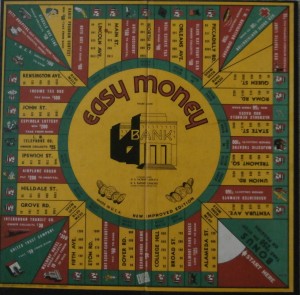 The Easy Money board game by Milton Bradley was first published in 1935 and competed against the all familiar game of Monopoly by Parker Brothers. Because of extreme similarities between the two games, Parker Brothers forced Milton Bradley to make a few changes to its game early on. The 1936 version of Easy Money reflects these alterations.
The Easy Money board game by Milton Bradley was first published in 1935 and competed against the all familiar game of Monopoly by Parker Brothers. Because of extreme similarities between the two games, Parker Brothers forced Milton Bradley to make a few changes to its game early on. The 1936 version of Easy Money reflects these alterations.
Both games were inspired by a previous 1904 patented board game called The Landlord’s Game. The Landlord’s Game was invented by Elizabeth Magie, and since she later sold her patent to Parker Brothers for 500 dollars in 1935, Parker Brothers gained rights to the rules and unique features for that particular game. This in turn provided the company the exclusive ability to successfully market Monopoly which replicated The Landlord’s Game more closely, and permitted them to force Milton Bradley to alter their game.
Most people have played a game of Monopoly and know the rules to the game. Players strive to buy and develop properties on the game board in order to collect payments/rent from opponents who land on the spaces. If players are unable to ‘pay up’, they are out of the game. The winner is the player who remains, and has therefore accumulated all the properties. The time it takes to complete a game is often hours.
Easy Money’s objective is the same. However, the game ends after only one player is unable to pay his rent. The player who has collected the most money and assets at this point wins the game. Differences between the games are also found in a few rules and board design. Easy Money’s game board includes 22 Property spaces featuring streets, avenues, or roads. There are also 5 Utility spaces, 3 Public Buildings, 1 Hospital, and 17 ‘Legend Spots’. These last spaces give direct instructions to a player.
The original 1935 game included the well known ‘deed cards’ to these properties, like those found in Monopoly. This, along with a ‘Give and Take’ card space on the board, had to be changed as the result of infringing on Parker Brothers’ rights. Because of this, the revised 1936 Easy Money game included this type of information directly on the board (as shown above). Beside each Property space, the cost to build and mortgage the property is listed. Within the space itself is listed the rent amounts based on the number of ‘houses’ developed on the street, avenue, or road. This amount is paid to the player who owns the property by a player who lands on the space. Easy Money does not include ‘deed cards’ anymore.
Another main difference between games is the rules to buying and developing properties. In Easy Money, when one player lands on a property space, all players are able to bid on it. The highest bidder wins and claims the space with one house. Players are only allowed to buy one property per side until they own one property from each side, though. This sometimes limits the number of bidders on a property, and gives both disadvantages and advantages to certain players.
Unlike Monopoly, the properties of Easy Money are independent of each other. Players can develop any single space. In Monopoly, players need a set to develop.
Both games have their appeal, and are fun to play. Monopoly, however, has gained the most popularity and has become one of the best well-known board games of the world. Monopoly’s tokens are even well known and collectible. Nonetheless, Easy Money plays just as well as Monopoly and makes for a nice change on game night.
Please feel free to Like/Follow All About Fun and Games for continuing information and ideas on Fun and Games!`


From my own personal experience, many times softening way up a photograph may possibly provide the photo shooter with a little bit of an imaginative flare.
I bought a 1903 built house a few months ago. During a renovation project I found 6 “Give-Or-Take cards, colored houses, a colored players piece, and a small die, all matching this game. I’m not sure what year version the game pieces are from, but the cards are an off-white with black ink.
In the late 1940s this was the money board game that I played as a child. It cost less than the Monopoly Game thus more affordable.